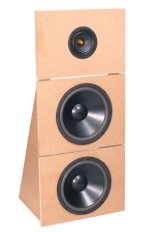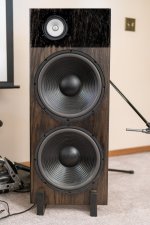Hello All,
I love my open baffles but the full-range driver sits quite a bit above my ear position and would love to drop it down. The easiest way to do this would be to eliminate one of the woofers. The question is whether or not adding a 14" wing (gives me 6db gain) is the same as just adding the second driver? Does the driver see a difference in more excursion or distortion level or is it "free" db? If it's free then I can just add the wing and ditch a driver and place the full-range driver at ear height. Or should I make this an mtm? Some day I would love to make this a coaxial design with just a woofer at the bottom, and a woofer/compression driver coaxial situation up top.
Thoughts? Also my response in room above 300hz is pretty trash as far as smoothness in the response ( I can upload some sweeps if anyone is interested). I think would need to move the listening position which I can't really do in this room due to some load bearing pillars behind the couch. They are about 3 ft from the front wall.

I love my open baffles but the full-range driver sits quite a bit above my ear position and would love to drop it down. The easiest way to do this would be to eliminate one of the woofers. The question is whether or not adding a 14" wing (gives me 6db gain) is the same as just adding the second driver? Does the driver see a difference in more excursion or distortion level or is it "free" db? If it's free then I can just add the wing and ditch a driver and place the full-range driver at ear height. Or should I make this an mtm? Some day I would love to make this a coaxial design with just a woofer at the bottom, and a woofer/compression driver coaxial situation up top.
Thoughts? Also my response in room above 300hz is pretty trash as far as smoothness in the response ( I can upload some sweeps if anyone is interested). I think would need to move the listening position which I can't really do in this room due to some load bearing pillars behind the couch. They are about 3 ft from the front wall.
To this...
Attachments
-
 83567bf633b853665b5d06d59531ade1.jpg163.1 KB · Views: 201
83567bf633b853665b5d06d59531ade1.jpg163.1 KB · Views: 201 -
 Trio15-TB-and-Trio10-TB-Open-Baffle-Speakers-Side-1.jpg262.7 KB · Views: 156
Trio15-TB-and-Trio10-TB-Open-Baffle-Speakers-Side-1.jpg262.7 KB · Views: 156 -
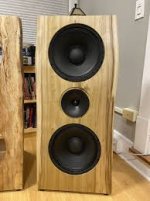 images.jpeg8.6 KB · Views: 152
images.jpeg8.6 KB · Views: 152 -
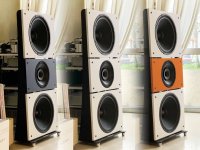 1d4d7df90db98664d916bd1c6921ad77.jpg66.3 KB · Views: 130
1d4d7df90db98664d916bd1c6921ad77.jpg66.3 KB · Views: 130 -
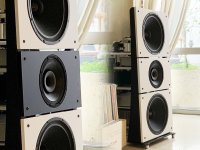 20201229133932_PureAudioProject-Trio15-Coax10-FrontWeb.jpg230.3 KB · Views: 145
20201229133932_PureAudioProject-Trio15-Coax10-FrontWeb.jpg230.3 KB · Views: 145
Have you all found any good instructions on the muli panel open baffle designs? I love the idea of being able to change single panels/drivers vs starting all the way over.
Sigma frame will make it a box, like in LX521
https://www.linkwitzlab.com/images/photos/LX521 variants/image024.jpg
https://www.linkwitzlab.com/images/photos/LX521 variants/image024.jpg
They are perfect in terms of aesthetics and near-perfect in terms of acoustics. And for the upper fullrange, the baffle edges artefact are very well distributed over time (as shown by the red lines in the picture below), thus providing a nice spread of these artefacts, contributing to a smoothing-out of the baffle diffraction step induced frequency anomalies (which in a dipole are quite hefty). Congratulations for this nice build! As for the blacked top, I will comment later.I love my open baffles ...
the full-range driver sits quite a bit above my ear position and would love to drop it down. The easiest way to do this would be to eliminate one of the woofers
No. The easiest and acoustically (in terms of bass efficiency) best way would be to cut the base to the minimum. Leaving only one inch between the floor and the lower woofer's rim. And you maybe may temporarly elevate your listening position also for the few very critical listening sessions. As said before, another reward of avoiding a space between the baffle and the floor is an increased SPL efficiency for the lower bass driver. But I must confess that aesthetically, an "airy", "floating" baffle might have a less thomb-stony look. Aesthetics vs. acoustics ...
The question is whether or not adding a 14" wing (gives me 6db gain) is the same as just adding the second driver?
No. Because of the hight related to the floor and for a lower frequency band, the upper woofer does produce less SPL into the room than the lower woofer. And enhancing the lower's woofer's efficiency by adding wings will not lead to the exact same result as you now have. See the curve "dipole normal" in the following graph:
ke is the frequency related distance of a monopole or the two dipole's orientations from a wall
Furthermore, adding wings is not a trivial thing and has consequences for the linearity of the setup. See Linkwitz for that one.
Or should I make this an mtm?
No. With an MTM, the upper woofer would even rise more in hight above the floor, which makes it less bass effective. See graph above.
And No again: With a MTM, you create more early reflections for the soundwave expanding over the non-plane baffle regions where the woofers are located. Within a full symmetric array, an MTM doubles these unwanted artefacts. See the two pictures below. Blue are the clean sectors only affected by the baffle edges artefacts. If you can avoid a MTM configuration, then avoid it (the only reason to go ...MTM... are Horbach-Keele designs):
The drawback of MTM shown on these above pictures is less illustrative because of the vertical asymmetic position of the upper wideband driver in your design.
In terms of minimizing and smoothing out these disturbances on the baffle (non-)plane, and for your design, I would try to add a thick felt plate around the upper fullrange driver, thus evening out the height step of the midhigh driver. The pictures above already shows the design of a felt plate only partially covering the upper part of the baffle. I like the look of this variant in the picture below:
Attachments
Last edited:
Thank you for taking so much time to go through each and every point I made. I really appreciate it. I was conscious of placing the full-range driver off-center to help with diffraction frequencies being spread out.They are perfect in terms of aesthetics and near-perfect in terms of acoustics. And for the upper fullrange, the baffle edges artefact are very well distributed over time (as shown by the red lines in the picture below), thus providing a nice spread of these artefacts, contributing to a smoothing-out of the baffle diffraction step induced frequency anomalies (which in a dipole are quite hefty). Congratulations for this nice build! As for the blacked top, I will comment later.
View attachment 1212345
No. The easiest and acoustically (in terms of bass efficiency) best way would be to cut the base to the minimum. Leaving only one inch between the floor and the lower woofer's rim. And you maybe may temporarly elevate your listening position also for the few very critical listening sessions. As said before, another reward of avoiding a space between the baffle and the floor is an increased SPL efficiency for the lower bass driver. But I must confess that aesthetically, an "airy", "floating" baffle might have a less thomb-stony look. Aesthetics vs. acoustics ...
No. Because of the hight related to the floor and for a lower frequency band, the upper woofer does produce less SPL into the room than the lower woofer. And enhancing the lower's woofer's efficiency by adding wings will not lead to the exact same result as you now have. See the curve "dipole normal" in the following graph:
View attachment 1212338
ke is the frequency related distance of a monopole or the two dipole's orientations from a wall
Furthermore, adding wings is not a trivial thing and has consequences for the linearity of the setup. See Linkwitz for that one.
No. With an MTM, the upper woofer would even rise more in hight above the floor, which makes it less bass effective. See graph above.
And No again: With a MTM, you create more early reflections for the soundwave expanding over the non-plane baffle regions where the woofers are located. Within a full symmetric array, an MTM doubles these unwanted artefacts. See the two pictures below. Blue are the clean sectors only affected by the baffle edges artefacts. If you can avoid a MTM configuration, then avoid it (the only reason to go ...MTM... are Horbach-Keele designs):
View attachment 1212339
View attachment 1212341
The drawback of MTM shown on these above pictures is less illustrative because of the vertical asymmetic position of the upper wideband driver in your design.
In terms of minimizing and smoothing out these disturbances on the baffle (non-)plane, and for your design, I would try to add a thick felt plate around the upper fullrange driver, thus evening out the height step of the midhigh driver. The pictures above already shows the design of a felt plate only partially covering the upper part of the baffle. I like the look of this variant in the picture below:
View attachment 1212343
- I think the answer is shaving a good couple inches off the bottom of the baffle, tilting the baffle slightly more forward (already tried this and the high end seemed a great deal better as well as the center imaging).
- I'm not sure on adding the wings since I cross to two subs around 60-80hz anyway so they don't have to try and produce anything very low in bass (although right now I'm running LFE+Main so they are playing down as low as they can go). Maybe I'll add a lowpass filter to stop them playing from 30hz or so below and keep LFE+Main.
- Any ideas on where to source the felt and how thick though I be looking for?
- I'll show some measurements as I find it strange I don't know if you see the dipole hump you're "supposed to see" at the listening position.
- Everything is run though apple tv, Denon x3500 preamp to miniDSP and then powered by Buckey class D 6-channel NC252MP amp (only using 4 channels right now).
Last edited:
I'm trying to stay away from boxes. I'm not very experienced in the woodworking department plus I'm already crossing to two a couple of 15" ultimax subs I built. Trying to keep this is simple and slims as possible.wht not putting the upper woofer behind the lower (push push or push pull) ?
Another could be to put them face to face but 180 rotated in a sloated à la Nelson Papa ?
WHat is the high pass of the upper full range ?
I think I only have like 4mm or something. And it's a low sensitivity driver at 88dbSome have made push pull without frame too. See open baffle illustration thread. If you have Xmax enough could be good.
... I'm not sure on adding the wings since I cross to two subs around 60-80hz anyway ...
While talking about x-over frequencies: Take the graph again ...
... and translate ke into frequencies related to the distance of the driver center from the ground floor.
For the lower woofer at it's center approx. 30cm above the floor this translates into somethin like this:
Because of the floor vicinity, for the lower woofer you have some gain below approx. 190Hz, and you get a first minimum around approx. 360Hz.
For the upper woofer at it's center approx. 65cm above the floor this translates into somethin like this:
For the upper woofer you have some gain below approx. 90Hz, and you get a first minimum around approx. 160Hz, then a max. again at some 310Hz.
The nice thing about the two woofers stacked one above the other is that e.g. the boosts and the mins are partially compensating each other. So e.g. the dip around 250Hz ... 450Hz for the lower driver gets partially compensated by the max. of the upper driver around 280Hz ... 350Hz. So the overall ripple will get much smoother than with any dipole bass solution spaced at one and the same distance from the ground floor.
There is a simple workaround for such a single-height woofer setup: In the case of the 30cm spacing, you would have to crossover at around 200Hz max. With a multi-distance solution instead you could cross higher up.
Life is not meant to be easy, but while not overwhelming, you may enjoy it's complexity. And in terms of complexity: This above layout is not very precise. It's a rough simulation. But it very well shows the pro's and the con's of the two different setups.
Thought I might come back and update anyone who is interested. I went back to my 3 way design with KEF Q100 driver up top and love the sound. I have to admit I don't know if it is due to the change in speaker or perhaps the change and addition of sound absorption in the room. I added some 20 or so 5.5" rockwool panels and 16 52hz resonators to the room to deal with some resonances in the room. I'm quite pleased!

- Home
- Loudspeakers
- Multi-Way
- Open baffle U frame question
